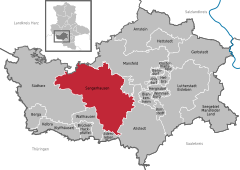Sangerhausen
Sangerhausen | |
|---|---|
 Sangerhausen | |
Location of Sangerhausen within Mansfeld-Südharz district  | |
| Coordinates:51°28′N11°18′E/ 51.467°N 11.300°E | |
| Country | Germany |
| State | Saxony-Anhalt |
| District | Mansfeld-Südharz |
| Government | |
| •Mayor(2024–31) | Torsten Schweiger[1](CDU) |
| Area | |
| • Total | 207.64 km2(80.17 sq mi) |
| Elevation | 154 m (505 ft) |
| Population (2022-12-31)[2] | |
| • Total | 25,441 |
| • Density | 120/km2(320/sq mi) |
| Time zone | UTC+01:00(CET) |
| • Summer (DST) | UTC+02:00(CEST) |
| Postal codes | 03464, 034656 (Großleinungen), 034658 (Breitenbach, Horla, Wolfsberg), 034775 (Wippra) |
| Dialling codes | 03464 |
| Vehicle registration | MSH, EIL, HET, ML, SGH |
| Website | www.sangerhausen.de |
Sangerhausen(German pronunciation:[zaŋɐˈhaʊzn̩]) is a town inSaxony-Anhalt,centralGermany,capital of thedistrict of Mansfeld-Südharz.It is situated southeast of theHarz,approx. 35 kilometres (22 miles) east ofNordhausen,and 50 km (31 mi) west ofHalle (Saale).About 26,000 people live in Sangerhausen (2020).
History
[edit]
Margraviate of Meissen1249–1291
Margraviate of Brandenburg1291–1372
Electorate of Saxony1372–1806
Poland-Saxony 1697–1706, 1709–1763
Kingdom of Saxony1806–1815
Kingdom of Prussia1815–1871
German Empire1871–1918
Weimar Republic1918–1933
Nazi Germany1933–1945
Allied-occupied Germany1945–1949
East Germany1949–1990
Federal Republic of Germany1990–present
Sangerhausen is one of the oldest towns in the historical region of Saxony-Anhalt, being first mentioned in a document created between 780 and 802 inFulda Abbey.
Sangerhausen is mentioned as the tithable placeSangerhusinFriesenfeldin theHersfeld Tithe Register,created between 881 and 899.
It is mentioned in a document of 991 as appertaining to the estates of the emperor, as part ofMemleben Abbey.
By marriage it passed to thelandgrave of Thuringia,and after 1056 it formed for a while an independent country. Having been again part of Thuringia, it fell in 1249 toMeissen,and in 1291 toBrandenburg.In 1372 it passed to theElectorate of Saxonyand formed a portion of that territory until 1815, when it became a part of thePrussianProvince of Saxony.
Historical population
[edit]

|
|
* After annexation of neighboring districts
** Population of Sangerhausen town in brackets
Municipality
[edit]

The municipality of Sangerhausen currently consists of 15 divisions, also called (in German)Ortschafte.These are:
- Breitenbach
- Gonna
- Grillenberg
- Großleinungen
- Horla
- Lengefeld
- Morungen
- Oberröblingen
- Obersdorf
- Riestedt
- Rotha
- Sangerhausen
- Wettelrode
- Wippra
- Wolfsberg
In 1994, the town of Sangerhausen, at that time still an independent municipality, became part of the so-calledVerwaltungsgemeinschaft Sangerhausen,a municipal association consisting of Sangerhausen itself and the two villages/municipalitiesEderslebenand Oberröblingen. On 29 April 2000 Edersleben left for theVerwaltungsgemeinschaft Helme.On 1 January 2005 the municipalities Gonna, Grillenberg, Horla, Lengefeld, Morungen, Obersdorf, Pölsfeld, Rotha and Wettelrode joined the association from theVerwaltungsgemeinschaft Südharzwhich was dissolved. Six months later, on 3 July 2005 Pölsfeld left for theVerwaltungsgemeinschaftAllstedt-Kaltenborn.
On 1 October 2005 theVerwaltungsgemeinschaft Sangerhausen,consisting then of 10 municipalities was dissolved and turned into the single town/municipality Sangerhausen; which meant that the 9 villages were truly annexed. On the same date Breitenbach, Großleinungen and Wolfsberg also joined, coming from the municipal associationRoßla-Südharz.On 1 December 2005 Riestedt followed, coming from theVerwaltungsgemeinschaftAllstedt-Kaltenborn.[4]Finally, Wippra was incorporated on 1 January 2008, coming from theVerwaltungsgemeinschaftWipper-Eine.[5]
Main sights
[edit]- Old Town Hall, erected in 1431–1437 after a previous edifice burned down in 1358
- Church of St. Mary (Marienkirche), built in 1350 inGothicstyle
- Church of St. James (Jakobikirche,1457–1542), a late Gothic hall edifice with a nave and three aisles. It has a 61 m-high, slightly tilting bell tower with a Baroque cover. The interior has a rich decoration painted by Georg Bottschild in 1665, while the choir stalls and the high altar are from an Augustinian monastery closed in 1539. It also houses numerous tombs and effigies.Johann Sebastian Bachapplied here in 1702 for the post of organist, but the job went toJohann Augustin Kobelius.
- Church of St. Ulrich (Ulrichkirche), one of the most interesting Romanesque edifices in Germany. It is a basilica built in 1116-1123, with a bell tower added in the 15th century. It has a nave and two aisles withgroin vault.The eastern part has five apses.
- TheAltes Schloss( "Old Castle" ), built by the lords ofMeissen.Only a tower remains. The New Palace orNeues Schlosswas built byKaspar Tryller,minister of Finances of theElectorate of Saxony,from 1612 to 1622. It is a Renaissance style, and now houses the county court.
Transport
[edit]Sangerhausen stationlies on theHalle–Hann. Münden railwayand theSangerhausen–Erfurt railway.
Twin towns – sister cities
[edit]Sangerhausen istwinnedwith:[6]
Notable people
[edit]
- Andreas Knebel(born 1960), athlete
- Thomas Liese(born 1968), cyclist
- Max Ludwig(1871–1961), general
- Manfred Möck(born 1959), actor
- Norbert Nachtweih(born 1957), footballer
- Werner Rothmaler(1908–1962), botanist and professor at the University of Greifswald
- Einar Schleef(1944–2001), director and writer
- Werner Stock(1903–1972), actor
- Annekatrin Thiele(born 1984), rower
- Julius von Bose(1809–1894), Prussian general of the infantry
References
[edit]- ^Bürgermeisterwahlen in den Gemeinden, Endgültige Ergebnisse,Statistisches Landesamt Sachsen-Anhalt.Retrieved 10 July 2024.
- ^"Bevölkerung der Gemeinden – Stand: 31. Dezember 2022"(PDF)(in German).Statistisches Landesamt Sachsen-Anhalt.June 2023.
- ^Zensusdatenbank
- ^Gebietsänderungen vom 01.01. bis 31.12.2005,Statistisches Bundesamt
- ^Gebietsänderungen vom 01.01. bis 31.12.2008,Statistisches Bundesamt
- ^"Partnerstädte".sangerhausen.de(in German). Sangerhausen.Retrieved2021-03-18.
- This article incorporates text from a publication now in thepublic domain:Chisholm, Hugh,ed. (1911). "Sangerhausen".Encyclopædia Britannica(11th ed.). Cambridge University Press.
Further reading
[edit]- Makos, Adam(2019).Spearhead(1st ed.). New York:Ballantine Books.p. 305.ISBN9780804176729.LCCN2018039460.OL27342118M.




